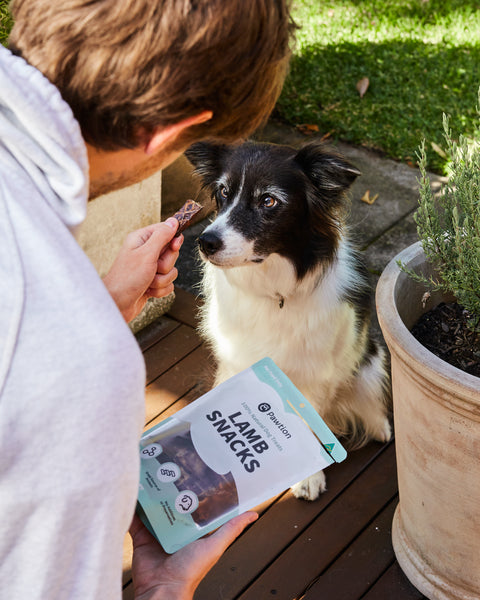Dogs thrive on routine and training, which is why positive reinforcement – the act of rewarding your dog for good behaviour – is encouraged when teaching commands or desired actions. Since food is a powerful motivator for dogs, rewarding with treats is an excellent way to approach food-oriented obedience training. Treats can also correct certain behaviours like resource guarding, possessiveness, and more.
While training with treats sounds simple enough, pet parents can still make mistakes that reduce training effectiveness, lead to undesirable conduct or hinder your pooch’s learning abilities.
Here are some common mistakes to avoid so your dog does not become treat dependent!
-
Giving the treat too slowly.
Correct timing is crucial when using treats for training. The reward must be given immediately – within seconds – after the desired behaviour, or else your pet may not associate it with the proper action.
For example, if you’re teaching your pooch to lie down but reward them after they’ve sat or stood back up, they’ll think they are being rewarded for those actions. Remember that dogs have short attention spans, so they will easily forget why they’re receiving a treat if you wait too long to give them one.
-
Rewarding bad behaviour.
While reinforcing whatever action preceded the treat, you should wait until your dog is in the right frame of mind before giving the reward. Don’t react to hyperactive behaviour and instead give the treat when they are in a calm, submissive state.

-
Using treats as a bribe.
Doing this prevents your furbaby from becoming treat dependent or accomplishing commands only when a treat is involved. Be sure to praise your dog – another form of positive reinforcement – after performing the desired behaviour. They will soon learn that if they keep responding with the correct action, they will get your praise and an occasional treat.
-
Relying on treats as the only reinforcement.
While pups are food motivated, other forms of positive reinforcement can be used to reward good behaviour. It can include anything from toys, affection, praise or exclaiming, “yes!” – all sorts of things your dog values.
When training your pooch, be sure to incorporate these other forms of positive reinforcement so you do not rely on treats alone. This will be helpful when weaning your dog off rewards so they can get used to following commands without having to involve external motivations.
-
Taking the treat away to assert dominance.
In a misguided attempt to assert dominance, owners may take treats or toys away just as their pup settles in to enjoy it. This can lead your dog to think that whenever a human approaches while they are playing with a toy or enjoying a treat, those two will disappear. They will then become more possessive of their treat or toy and respond defensively. Remember that a treat should be given to reward good behaviour and not be taken away as punishment.

-
Using low value treats

For a surefire reward any dog will love, natural treats made with single source proteins like Pawtion’s Treat Range will have your furry friends wagging their tails with excitement. Try the Green-Lipped Mussels, which are small enough to eat quickly and will have them looking for more. These are packed with omega-3 fatty acids for heart health and brain function, glucosamine for joint health and chondroitin for maintaining the cartilage and promoting overall joint flexibility and mobility.

Another option is the Beef Snacks, which pups will find hard to resist! Break it off into small pieces to capture your dog’s attention and aid in the reinforcement of good recall. They’re low fat treats that are a great source of iron and protein, with no additives or preservatives!
Make sure to give a variety of treats so your pooch won’t become bored of getting the same reward every time. Other incredible options from Pawtion include Lamb Snacks (packed with amino acids), Pork Snacks (a great source of vitamin B12), Mackerel Slivers (for healthy skin and coat and boost the immune system) and Beef Liver (rich in Vitamin A and B12)!
Treats are powerful motivators, but use them wisely
Treats are a great way to influence good behaviour, quickly helping dogs learn commands and hone their skills. The key is to use these treats correctly so they do not lead to confusion, bad behaviours or your pup becoming treat dependent. Remember to pay attention to your pet so you can correct any mistakes immediately and choose the best form of positive reinforcement that can make your dog happy and well behaved!
